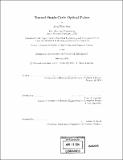| dc.contributor.advisor | Franz X. Kaertner. | en_US |
| dc.contributor.author | Kim, Jung-Won, 1976- | en_US |
| dc.contributor.other | Massachusetts Institute of Technology. Dept. of Electrical Engineering and Computer Science. | en_US |
| dc.date.accessioned | 2006-03-29T18:35:18Z | |
| dc.date.available | 2006-03-29T18:35:18Z | |
| dc.date.copyright | 2004 | en_US |
| dc.date.issued | 2004 | en_US |
| dc.identifier.uri | http://hdl.handle.net/1721.1/32336 | |
| dc.description | Thesis (S.M.)--Massachusetts Institute of Technology, Dept. of Electrical Engineering and Computer Science, 2004. | en_US |
| dc.description | Includes bibliographical references (p. 143-151). | en_US |
| dc.description.abstract | Single-cycle optical pulses, the never-before-achieved regime, have a great potential for attosecond science and phase-sensitive nonlinear optics. To achieve single-cycle optical pulses by active synchronization, three major steps are required. Firstly, two very stable and broadband mode-locked lasers with overlapping spectra are necessary. Secondly, a tight timing synchronization with timing jitter under one-tenth of the synthesized pulsewidth has to be implemented. Finally, the carrier-envelope offset frequency lock between two lasers completes the coherent pulse synthesis process. In this thesis, the major ideas, techniques, and experimental results for single-cycle optical pulse synthesis are presented. A broadband Cr:forsterite laser mode-locked by a semiconductor saturable absorber is designed and implemented. The output spectrum spans from 1080 nm to 1500 nm range, and has a 3-dB bandwidth of 90 nm. This is the broadest spectrum from a prismless Cr:forsterite laser to our best knowledge, and corresponds to a sub-20 fs Fourier-transform limited pulsewidth. A new broadband output coupler is designed to optimize the output spectrum of an octavespanning Ti:sapphire laser. The resulting combined spectrum covers 1.5 octave from 600 nm to 1500 nm and has a strong overlap in 1100 to 1200 nm range, which enables a strong beat-note signal between the two lasers. A tight timing synchronization between the two lasers is achieved by balanced cross-correlation. The resulting timing jitter is 300 attoseconds, which is less than one-tenth of the synthesized pulsewidth. | en_US |
| dc.description.abstract | (cont.) For a high-quality pulse synthesis, an ultra-broadband 50:50 beam splitter, a bandpass filter beam splitter, and a tapping beam splitter are designed with optical thin-film multilayer structures. A novel scheme for synchronization of an RF-signal to the pulse train of a mode-locked laser is proposed. Currently the isolation of cross-talk between two locking loops for repetition rate and carrier-envelope phase is under investigation, and it is expected to generate true single- cycle optical pulses in the near future. Future work will include full characterization of the synthesized pulses with SPIDER (spectral phase interferometry for direct electric-field reconstruction) and novel phase-sensitive nonlinear optic experiments. | en_US |
| dc.description.statementofresponsibility | by Jung-Won Kim. | en_US |
| dc.format.extent | 151 p. | en_US |
| dc.format.extent | 6280040 bytes | |
| dc.format.extent | 6288174 bytes | |
| dc.format.mimetype | application/pdf | |
| dc.format.mimetype | application/pdf | |
| dc.language.iso | eng | en_US |
| dc.publisher | Massachusetts Institute of Technology | en_US |
| dc.rights | M.I.T. theses are protected by copyright. They may be viewed from this source for any purpose, but reproduction or distribution in any format is prohibited without written permission. See provided URL for inquiries about permission. | en_US |
| dc.rights.uri | http://dspace.mit.edu/handle/1721.1/7582 | |
| dc.subject | Electrical Engineering and Computer Science. | en_US |
| dc.title | Toward single-cycle optical pulses | en_US |
| dc.type | Thesis | en_US |
| dc.description.degree | S.M. | en_US |
| dc.contributor.department | Massachusetts Institute of Technology. Department of Electrical Engineering and Computer Science | |
| dc.identifier.oclc | 61388682 | en_US |
